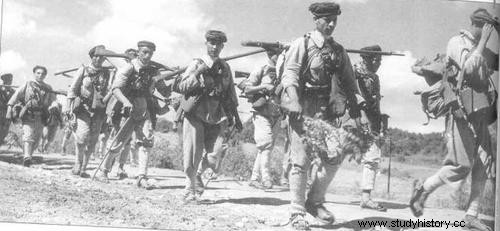
We left the 19th corps established south of the plain of Pont-du-Fahs and the steep-sided Pont-du-Fahs - Saouaf road, facing the Zaghouan. For the attack set for May 4, General Koeltz gave the following instructions:
• Left. the division of Oran will seize the threshold of Pont-du-Fahs, thus opening the way to the armored group Le Couteulx, which will push on Depienne and the village of Zaghouan to arrive on the rear of the defenders of the massif and cut their communications;
• In the center, Morocco's division will attack the massif itself and its jumble of ridges, dominated by the central peak of Zaghouan;
• On the right, the division of Algiers will support the Moroccan division by pushing on the southern and eastern foothills of the Zaghouan, towards Zriba, and by monitoring the Saouaf flow, taken by the road to Enfidaville.
On May 4 - at noon, in full sun, the French assault was launched under enemy artillery fire which swept the plain.
In the west, to the division of Oran, the Algerian skirmishers and the legionnaires advance under the shells in very diluted formations so as to reduce the losses, but they are stopped south of Pont- du-Fahs by the precise fire of the enemy artillery, while they themselves are without artillery support, because our batteries of 75, at end of range, cannot advance by day in the beaten plain. br class='autobr' />In the center, the Moroccan skirmishers and goumiers manage to cross the depression in the road and cling to the first crests of the Zaghouan. They then progress step by step in this tormented massif, deploying their qualities of rugged mountaineers. But they come up against a stubborn defense of the Afrika Korps, richly equipped with machine guns and mortars, supported by powerful artillery and which has the magnificent observatory of the Pic du Zaghouan, from which nothing escapes.
To the right of the Morocco division, the Algiers division could not cross the depression on the road to Saouaf, in which the slightest movement, even isolated ones, provoked intense artillery barrages. Only, on the left, the Bouvattier battalion, of the 9th R.T.A., managed, on the 5th, to cross the road and cling to the slopes of Jebel Leri, the southern buttress of Zaghouan, fortunately supported, on its left, by the dominant fires of the Moroccan battalion on the right, the Beaufre battalion, established on the southern edge of the massif.
May 7, on the left, the division of Oran captured Pont-du-Fahs, opening the road to Depienne to the Le Couteulx armored group.
But that day, the decision had already been taken in the north, in Tunis. From then on, the fierce fighting which would continue in Zaghouan until the 11th would only have a fixing character for the final phase of British exploitation of the "Vulcan" manoeuvre.
But if, in the first two days, May 4 and 5, the 19th corps was unable to blow up the enemy pivot of the Zaghouan, it played its role perfectly for the benefit of the main maneuver. Worried by this threat to the hinge of its device, the German command maintained until May 6 its 21st panzer division in Zaghouan, far from Medjez, where the rupture was to occur. And on the 4th, on learning of the French attack, he even withdrew from Massicault, that is to say exactly from the road which was to be the axis of British effort two days later, two battalions of anti-tank guns, which 'He headed north of Pont-du-Fahs and Sebkret-Kourzia.
Let us now turn to the British breaking front.
